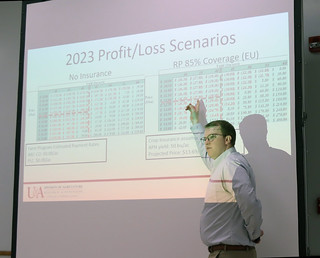New Census of Ag points out differences in risk protection
For a deeper dive, Biram also has a workbook called the Fundamentals of Federal Crop Insurance.
By Mary Hightower
U of Arkansas System Division of Agriculture
Feb. 27, 2024
Fast facts:
- Crop Insurance payments per farm nearly double from 2017 to 2022
- Crop insurance offers more tailored coverage, Biram said.
(500 words)
(Newsrooms: This is the first in a series of stories drawn from data in the 2022 Census of Ag; With art )
LITTLE ROCK — Data in the new Census of Agriculture has pointed out some significant differences in risk management programs for farmers, said Hunter Biram, extension economist for the University of Arkansas System Division of Agriculture.
The Census of Agriculture, published by the U.S. Department of Agriculture’s National Agricultural Statistics Service, offers a very broad snapshot of the farming sector in its 757 pages. The latest version, 2022 Census of Agriculture, was released Feb. 13. The previous version was released in 2017.
The USDA Risk Management Agency’s “Crop Insurance appears to provide more risk protection than the Agriculture Risk Coverage and Price Loss Coverage programs offered by the Farm Service Agency,” Biram said.
Agriculture Risk Coverage and Price Loss Coverage, better known as ARC and PLC, are offered by FSA to provide financial protection to farmers against drops in crop prices or revenues. On the other hand, Crop Insurance, provided by private companies and subsidized by USDA’s Risk Management Agency, provides coverage against production losses due to drought, hail, frost, hurricanes, excessive moisture, fire, insects, plant disease and other causes.
Biram said the differences between ARC/PLC and crop insurance are “indicated by nearly double the average payments per farm for crop and livestock insurance payments — increasing from $26,388 to $52,819 per farm” since the 2017 census.
Another category that saw increases were government payments from conservation programs, as well as loan deficiency and disaster payments.
“Government payments per farm averaged around 55 percent more between 2017 and 2022, increasing from $13,906 to $21,599 per farm,” Biram said.
“This is driven by myriad factors such as the fact that the most popular crop insurance programs offer a farm-level revenue trigger, compared to FSA programs which provide county-level revenue trigger, so you get more specific, more tailored protection from Crop Insurance relative to ARC or PLC,” he said. “Another driver is the fact that Price Loss Coverage payments have waned across all major program crops in recent years, even in rice.
“Soybeans have never received a PLC payment. Corn and Seed Cotton have received a few PLC payments. There is a chance rice and peanuts do not trigger a PLC payment for the third year in a row.,” he said.
PLC is administered by FSA under Title 1, the commodities portion of the Farm Bill, while federal crop insurance is administered by the Risk Management Agency. For a summary of this public-private partnership, see The Structure of the U.S. Crop Insurance Industry.
For a deeper dive, Biram also has a workbook called the Fundamentals of Federal Crop Insurance.
Census history
The first Census of Agriculture was conducted by the Census Bureau in 1840 across 26 states and the District of Columbia. In 1997, the task was transferred to the National Agricultural Statistics Service and now encompasses all 50 states plus Puerto Rico, Guam, the U.S. Virgin Islands, American Samoa and the Northern Mariana Islands.
Information in the census can be viewed by national, state and county levels, as well as congressional districts, watersheds and zip codes.
To learn about extension programs in Arkansas, contact your local Cooperative Extension Service agent or visit www.uaex.uada.edu. Follow us on X and Instagram at @AR_Extension. To learn more about Division of Agriculture research, visit the Arkansas Agricultural Experiment Station website: https://aaes.uada.edu. Follow on X at @ArkAgResearch. To learn more about the Division of Agriculture, visit https://uada.edu/. Follow us on X at @AgInArk.
About the Division of Agriculture
The University of Arkansas System Division of Agriculture’s mission is to strengthen
agriculture, communities, and families by connecting trusted research to the adoption
of best practices. Through the Agricultural Experiment Station and the Cooperative
Extension Service, the Division of Agriculture conducts research and extension work
within the nation’s historic land grant education system.
The Division of Agriculture is one of 20 entities within the University of Arkansas System. It has offices in all 75 counties in Arkansas and faculty on five system campuses.
The University of Arkansas System Division of Agriculture offers all its Extension and Research programs and services without regard to race, color, sex, gender identity, sexual orientation, national origin, religion, age, disability, marital or veteran status, genetic information, or any other legally protected status, and is an Affirmative Action/Equal Opportunity Employer.
# # #
Media contact: Mary Hightower
mhightower@uada.edu
